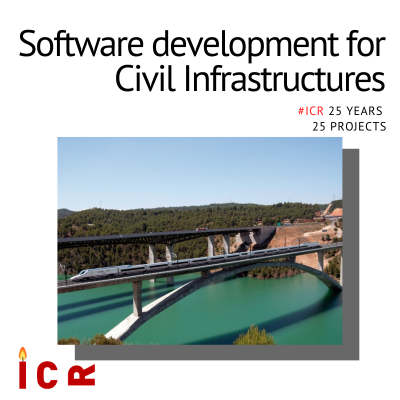Project 14: Software development for vibration control of civil infrastructures (2010 – 2012)
In the vibro-acoustic engineering sector, it is very common to analyse the vibrations generated by various industrial equipment (generators, pumps, etc.), vehicles (trains, cars, aeroplanes, etc.). Even vibrations generated by large wind turbines.
What happens when a vibration analysis of civil infrastructures is needed?
Civil infraestructures such as bridges are not built every day. Because of this, large engineering and construction companies usually need the support of specialists in the vibro-acoustic field, such as ICR, to study and analyse them once they have been built.
In this project in particular, the Spanish company TIFSA (Tecnología e Investigación Ferroviaria, S.A) contacted us in 2010 to request the development of specific software for semi-automated operational modal analysis (OMA) in civil infrastructures.
Specifically, this project was developed between 2010 and 2012. For the study of the Contreras Viaduct, which is located between the provinces of Valencia and Cuenca. Through this bridge a high-speed line between Madrid and the Region of Murcia runs.
The software developed was created to achieve two main goals:
- Allow its usage on site during the measurement campaign
- Reduce the number of sensors required for a complete analysis
PROJECT METHODOLOGY
The selected strategy was to measure by sectors, while keeping some measurement points as a reference. The overall results were obtained afterwards by processing each package of partial results.
Due to the fact that it was important to be able to obtain consistent results quickly. After acquiring data, the software had to be used during on-site measurements, in order to determine whether each measurement had the required information or not.
All these measurements required a large number of variables to be considered during the calculation of the operational modal analysis (OMA). Moreover, the software was specifically designed to be able to manage and organise all measurements, as well as to support a large amount of data. The algorithm for the OMA software developed was based on the Auto-FDD method, a non-parametric method in the frequency domain. The programme generates reports automatically, and also provides a simplified version for quick validation of results on site.
At the end of the development, this software was acquired by Ofiteco, an international engineering company with more than 45 years of experience, dedicated to consultancy in hydraulic-environmental and transport engineering works.
Our NewsletterDid you find interesting this new? If so, subscribe to our Newsletter to stay up to date with our projects!
|







